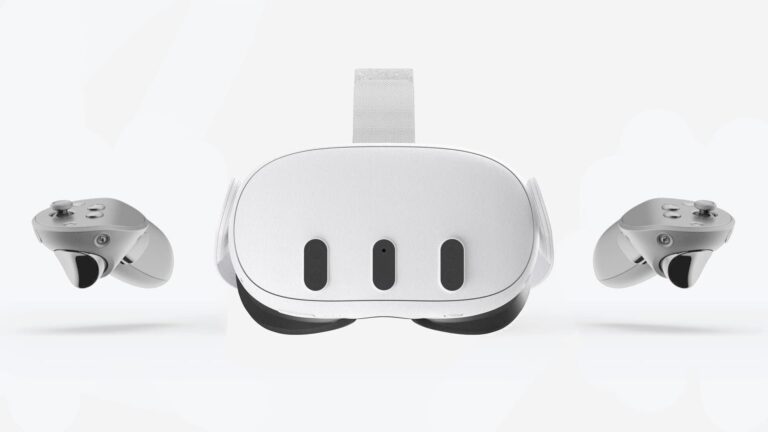
As you may have heard, Meta announced Q1 earnings last week. The company had a decent quarter with $36.5 billion in revenue. Though it beat analyst expectations, Meta’s stock took a beating following the earnings, as momentum slowed a bit from Q4’s breakout results.
Resting under those high-level results, Meta Reality Labs’ (MRL) revenue was $440 million. This is up 30 percent year-over-year, but down 59 percent quarter-over-quarter. The former is the more apples-to-apples metric considering cyclical patterns (e.g., Q4’s holiday surge).
Speaking of cycles and sales patterns, Q1 year-over-year growth can also be attributed to MRL underperformance in 2023. That represented the waning stages of Quest 2’s lifecycle. Similarly, Q1 2024’s growth is mostly due to renewed VR demand from Quest 3’s entrance.
There’s a lot to be said about that timing and market positioning. But our main question today is how Q1 revenue translates to headset unit sales. This is an exercise we’ve done every quarter for several years, which helps inform broader VR momentum and market sizing.
Data Dive
Diving in, Reality Labs made $440 million in Q1, as noted. As done in the past, we can use this figure to reverse-engineer unit sales. This exercise gets harder and harder every year due to more revenue sources. It’s not just Quest 1 & 2 anymore… but several headsets in the mix.
To that end, we’ve estimated Meta Reality Labs’ revenue share breakdowns based on several signals we’re tracking. You can see those share estimates below. In this hardware-centric exercise, we’ll focus on the last four bullets, which account for 80 percent of MRL revenue.
- VR software (game & app sales): 18 percent*
- First-party accessories (head straps, etc): 2 percent
- Quest 2: 19 percent
- Quest 3: 40 percent
- Quest Pro: 1 percent
- Ray-Ban Meta Smart Glasses: 20 percent
Quest 2
Based on the above revenue shares, Quest 2’s estimated Q1 revenue is $83.6 million. Considering a Q1 average unit price of $269**, Meta sold an estimated 310,781 units during the quarter.
Quest 3
Based on the above revenue shares, Quest 3’s estimated Q1 revenue is $176 million. Considering a Q1 average unit price of $549***, Meta sold an estimated 320,583 units during the quarter.
Quest Pro
Based on the above revenue shares, Quest Pro’s estimated Q1 revenue is $4.4 million. Considering a Q1 unit price of $999, Meta sold an estimated 4,404 units during the quarter.
Ray-Ban Meta Smart Glasses
Based on the above revenue shares, RBMS estimated Q1 revenue is $88 million. Considering a Q1 unit price of $329, Meta sold an estimated 267,477 units during the quarter.
Grand Total
Adding up all headsets, we get an estimated 903,245 units sold in Q1 – or 635,768 if considering just VR headsets.
*This figure represents the Oculus Store’s gross revenue, before developer payouts, which are usually 70 percent after taxes. Meta realizes 100 percent of revenue in some cases, such as first-party titles and releases from VR game studios it has acquired (e.g., Beat Games).
**Meta recently applied a permanent price cut to Quest 2 to clear inventory, making the device $199. However, during the period in question (Q1), Quest 2’s base model (128GB) was $249 while the 256GB model was $299. This averages out at $269, given weighted sales at the lower end.
***During Q1, Quest 3’s 128GB base model was $499.99 while the 512GB model was $649.99. This averages out to $549, given weighted sales at the lower end.
Halo Effect
So there you have it. Of course, much of this exercise is based on the above-estimated revenue shares across Meta Reality Labs’ commercial products. Those share estimates are educated but up for debate: anyone can adjust them and calculate accordingly using the above model.
We should also address the elephant in the room: Meta Reality Labs’ ongoing expenses. They reached $4.92 billion, which is substantial but an improvement from the record $5.72 billion in Q4. The headline here is astronomical losses as Meta invests in the future of computing.
The other factor that plays into the above figures is Meta’s XR adoption accelerants. The first was already noted: renewed VR demand given the novelty, performance, and value of Quest 3. The same can be said for the breakout-hit Ray Ban Meta Smartglasses, now with multimodal AI.
The second accelerant sits down the road in Cupertino: Vision Pro. Apple tends to mainstream entire product categories when it enters markets. In Vision Pro’s case, this halo effect boosts mixed-reality demand and could buoy competitive devices with drastically lower price tags.
Quest 3 is at the top of that list, followed by immersive entertainment devices (Vision Pro’s top-marketed use case) such as Xreal Air 2. Put more simply and directly, Vision Pro could have a part in propelling Quest 3 sales. But in fairness, Quest 3 is reputable on its own merits.
In that sense, Meta has validated meaningful demand and turned things around from last year. It still has ways to go, but these Q1 results offer continued encouragement as a sort of VR rally cry. We’ll keep tracking demand signals to piece together the puzzle of VR unit sales.

